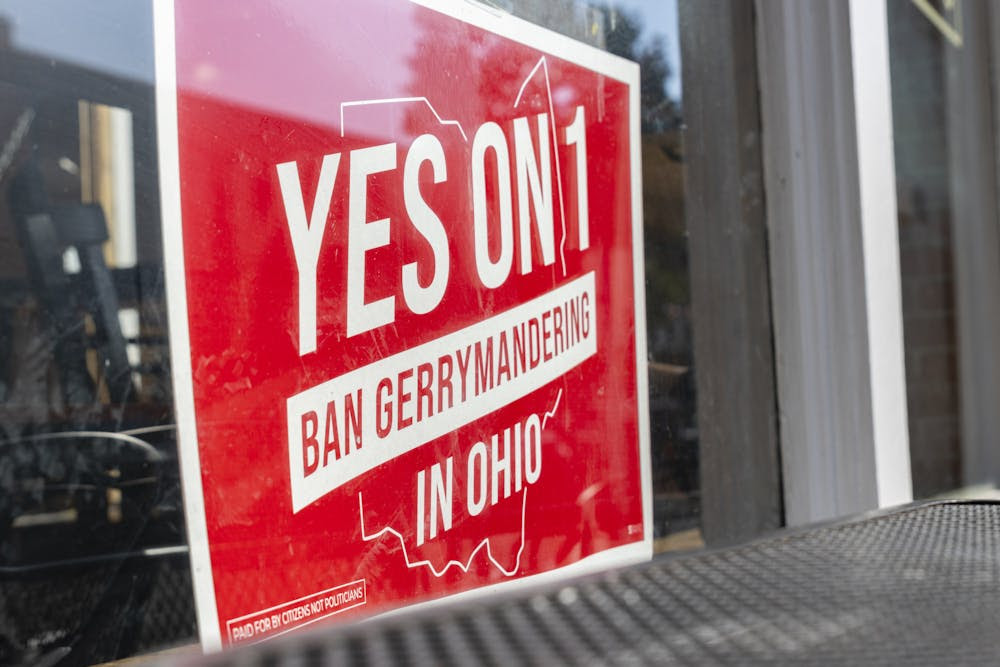As many students make the weekly trip from campus to East State Street to buy groceries or for retail therapy, the inevitable passing of political signs outside homes catches eyes and creates conversation.
The signs typically include visual endorsements of “Kamala-Walz” or “Trump-Vance.” Some are issue-based, like the citizen-led initiative Issue 1, which said “Vote Yes” or “Vote No.” Issue 1 has become a popular topic for Ohio voters in the Nov. 5 election.
According to Ohio University Lancaster associate professor of political science Linda Trautman, Issue 1 is on the ballot for Ohio voters because Ohio voters initiated it, practicing their democratic right to the redistricting process.
“It is a measure that will determine the future of control of the redistricting process in Ohio,” Trautman wrote in an email.
Trautman said voting in favor of Issue 1 will change the district drawing process and include citizens.
“Voting yes means providing citizens’ voices in the redistricting decision-making process,” Trautman wrote in an email.
According to All About Redistricting, voting to oppose Issue 1 will protect the nine-year-long Ohio Redistricting Commission. The commission draws districts based on the recent Census results, according to the Ohio Redistricting Commission website.
“Voting no means maintaining the current process of redistricting controlled by politicians—Bipartisan Redistricting Commission and voting,” Trautman wrote in an email.
In other terms, Issue 1 is deciding whether gerrymandering will end in Ohio. According to the Citizens Not Politicians organization website, politicians and lobbyists in Ohio manipulate voting districts to protect their interests and guarantee their reelection, causing incumbents running for reelection to rarely lose.
“In other words, we let politicians choose their voters,” according to the Citizens Not Politicians website. “The Citizens Not Politicians Amendment bans lobbyists and politicians from the process and instead empowers voters to choose their politicians.”
Trautman said gerrymandering focuses on politicians’ gains in voting outcomes and deprives representation in the country.
“Gerrymandering is the manipulation of district boundaries,” Trautman wrote in an email.
Trautman noted different types of gerrymandering, such as partisan gerrymandering, which is drawing district lines to advantage one party, and racial gerrymandering, which is drawing district lines to negatively impact minorities’ voting power.
According to Citizens Not Politicians, Ohio is among the 10 most gerrymandered states.
“It typically maintains a monopoly on ‘political power’ in this country,” Trautman wrote in an email. “It denies a fully functioning democracy that reflects the political inclusion of all citizens.”
According to a recent article from The Post published Oct. 1, 41 million members of Generation Z will be eligible to vote in the upcoming general election. Much of OU’s students falls in the Gen Z category.
“It is absolutely important that students vote on Issue 1,” Trautman wrote in an email. “It has significant implications regarding whether they are represented within American democracy (great representational consequences, the degree of public school funding, etc.).”
Dan Gordillo, a senior majoring in political science and Student Senate president said young voters have the most to lose in this election because they have the most future in America.
“There’s a war in Europe, tensions are rising in East Asia, the Middle East is facing another conflict,” Gordillo said. “Who are the people that are going to be sent boots on the ground to stop that if the United States gets involved? It’s going to be young people.”
According to Gordillo, Senate office has Ohio absentee ballot request forms for students not registered in Athens.
“You can fill out a ballot from the comforts of your own home, and then you can walk back to the same post office here in Baker and mail it,” Gordillo said. “Bam, you voted. You did it. You did what you were supposed to do.”
Gordillo said regarding Issue 1, students must understand the capacity to vote yes or no.
“The laws that really affect us are not made at the federal level, but they’re really active at the state level,” Gordillo said.
Trautman said students can learn more by talking to the Board of Elections in their respective county and contacting nonpartisan organizations, such as Common Cause of Ohio and voteohio.gov.
Read the original piece here.

